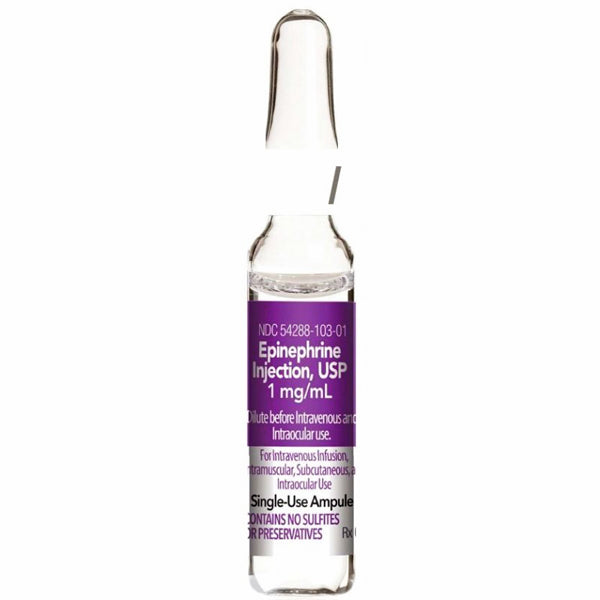Epinephrine
Published (updated: ).

Indications
Epinephrine is one of the most commonly used agents in various settings as it functions as medication and hormone. It is currently FDA-approved for various situations, including emergency treatment of type 1 hypersensitivity reactions, including anaphylaxis, induction, and maintenance of mydriasis during intraocular surgeries and hypotension due to septic shock. Off-label uses of epinephrine include, but are not limited to, ventricular fibrillation, pulseless ventricular tachycardia, asystole, pulseless electrical activity (PEA), croup, and severe asthma exacerbations unresponsive to standard treatment. In the operating room (OR) setting, epinephrine is also used as a local anesthetic block. Produced by the adrenal medulla, epinephrine plays a vital role in the body’s acute stress response by stimulating the sympathetic nervous system.
Mechanism of Action
Epinephrine is a sympathomimetic catecholamine that exerts its pharmacologic effects on both alpha and beta-adrenergic receptors using a G protein-linked second messenger system. It has a greater affinity for beta receptors in small doses. However, large doses produce selective action on alpha receptors. Through its action on alpha-1 receptors, epinephrine induces increased vascular smooth muscle contraction, pupillary dilator muscle contraction, and intestinal sphincter muscle contraction. Other significant effects include increased heart rate, myocardial contractility, and renin release via beta-1 receptors. Beta-2 effects produce bronchodilation, which may be useful as an adjunct treatment of asthma exacerbations and vasodilation, tocolysis, and increased aqueous humor production.
Administration
Depending on the diagnosis, epinephrine administration can be in various forms. For the treatment of anaphylaxis, epinephrine is preferably injected intramuscularly into the anterolateral aspect of the thigh due to rapid absorption. Subcutaneous injection is also an option. For advanced cardiovascular life support (ACLS), patients can receive epinephrine intravenously or intraosseous if needed. Another route of administration is through an endotracheal tube often used in neonatal resuscitation.
Adverse Effects
Adverse Effects Listed by System
- Central nervous system (CNS): Anxiety, dizziness, nervousness, agitation, headache, Parkinson disease exacerbation
- Cardiovascular: Arrhythmias, chest pain, hypertension, palpitations, tachycardia, cerebrovascular accidents, ventricular ectopy, vasospasm, tissue ischemia
- Dermatologic: Gangrene at the injection site (especially in buttocks), skin necrosis with extravasation
- Endocrine: Hyperglycemia, hypokalemia, lactic acidosis
- Gastrointestinal: Nausea, vomiting, increase in AST and ALT
- Neuromuscular: Tremors, weakness
- Renal: Decreased renal perfusion
- Respiratory: Dyspnea, pulmonary edema
The more common side effects include tachycardia, hypertension, headache, anxiety, apprehension, palpitations, diaphoresis, nausea, vomiting, weakness, and tremors.
Drug Interactions
- Alpha-adrenergic blockers: Antagonizes pressor effects
- Antihypertensives: Antagonizes pressor effects
- Vasodilators: Antagonizes pressor effects
- Diuretics: Antagonizes pressor effects
- Beta-adrenergic blockers: Potentiates pressor effects
- Monoamine oxidase (MAO) inhibitors: Potentiates pressor effects
- Catechol-o-methyltransferase (COMT) inhibitors: Potentiates pressor effects
Careful monitoring of vital signs is crucial, especially in patients with polypharmacy.
Contraindications
There are no absolute contraindications against using epinephrine. Some relative contraindications include hypersensitivity to sympathomimetic drugs, closed-angle glaucoma, anesthesia with halothane. Another unique contraindication to be aware of is catecholaminergic polymorphic ventricular tachycardia. As is the case with prescribing any medication, all practitioners should use clinical judgment and evaluate the benefits versus risks with epinephrine.
Select circumstances indicate the need for additional assessment before using epinephrine, as discussed below.
Pregnancy
Epinephrine is considered a pregnancy Category C medication under the old FDA categorization system. There are no well-controlled studies in humans, although animal studies have shown a teratogenic risk during organogenesis. It is capable of crossing the placenta. Epinephrine use requires caution when maternal blood pressure is 130/80 mm Hg and greater.
Labor and Delivery
Due to its effect on beta-2 adrenergic receptors causing tocolysis, epinephrine opposes the actions of oxytocin on the uterus and may delay labor. It also requires caution during anaphylaxis-induced hypotension in pregnancy as it may lead to uterine vasoconstriction, thus decreasing oxygen delivery to the fetus.
Breastfeeding
More clinical studies are needed to determine if epinephrine is excreted through breast milk.
Pediatrics
Epinephrine is effective at a dilution of between 1 to 100,000 and 1 to 400,000 for mydriasis induction and maintenance in pediatric intraocular surgeries.
Geriatrics
Due to the expected decrease in renal, hepatic, and cardiac function of geriatric patients, epinephrine should be started at the lower end of the dosing regime and titrated appropriately for clinical effect.
Location
Several locations should be avoided when injecting epinephrine, specifically the digits, nose, penis, and toes, as these areas are more prone to ischemia. Avoid using epinephrine in tissues supplied by end arteries.
Monitoring
When administered parenterally, epinephrine has a rapid onset but a short duration of action. When given intravenously, it has a half-life of fewer than 5 minutes. Metabolism is primarily in the liver, along with various other locations such as the kidneys, skeletal muscle, and mesenteric organs.
Epinephrine is a hormone that produces widespread effects. Certain effects need monitoring. Tachycardia and hypertension are expected effects when giving epinephrine intravenously, so it is important to titrate the drug carefully while monitoring hemodynamics.
Renal impairment requires monitoring as epinephrine causes renal blood vessel constriction and can decrease urine impairment. In patients with chronic kidney disease (CKD) and various other renal pathologies, clinical judgment is necessary.
Toxicity
Administration of excess epinephrine that leads to supra-therapeutic levels may cause predictable adverse effects that warrant supportive treatment. Overdose may cause elevated arterial pressures leading to cerebrovascular accidents. Pressor effects can be minimized by using an alpha-adrenergic blocker or by the usage of vasodilators such as nitrites. Pulmonary edema can also present due to the underlying mechanism of peripheral vasoconstriction along with myocardial stimulation.
